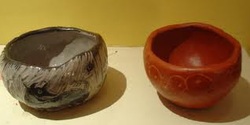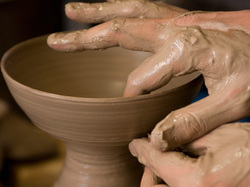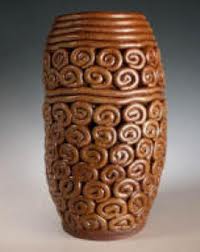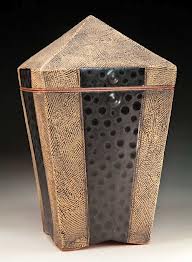
Pinch pottery is a very old way to make pottery. You mold it by hand. So, your hands will get really messy. Take a a ball of clay. Then with your thumb, starting in the middle, push the clay outwards and down. Do this until you get the shape of the bowl that you want. I remember doing this when I was in like kindergarten or 1st grade. It was a very long time ago. But, fun.http://pottery.about.com/od/pinchpots/tp/pinch101.htm <--- that link is where i got some of the information.
i think in my ceramics class, I think we could be more creative pinching. you mostly see just pots. but, why not add like faces to the pots. I seen on this one website, a pinch pot ear. Like it was an actual human ear. Kinda weird but it isn't just another pot. I think i would make like a little mushroom house.

I found something on Ceramic Arts Daily about Wheel Throwing. Basically, what I found out is that it takes more clay then you would think. Sometimes you need to add clay. And then other times you have to take away clay. So, sometimes you sure always have some extra clay just in case.http://ceramicartsdaily.org/pottery-making-techniques/wheel-throwing-techniques/wheel-throwing-video-how-to-throw-a-large-vase-in-two-parts-on-the-pottery-wheel/
The video above shows a guy making a giant bowl using a potters wheel. I would love to make a bowl in ceramics class. But, I think we could try to make other things to.

Coiling has been a way to shape clay into vessels for many years. They have used this method in a variety of ways. Using the coiling technique, it is possible to build thicker or taller walled vessels, which may not have been possible using earlier methods. The technique permits control of the walls as they are built up and allows building on top of the walls to make the vessel look bigger and bulge outward or narrow inward with less danger of collapsing. There are many ways to build ceramic objects using the coiling technique. To do this, you take a pliable material (usually clay) then roll it until it forms a long roll. Then, by placing one coil on top of another, different shapes can be formed.One of the methods used in terra-cotta sculpture; the clay is rolled into cylindrical strips about the size of an ordinary pencil and wound up to create the desired shape.
There are many things you can make by coiling. Bowls, cups, vases, kettles, and even plates. I saw this coiled elephant. I think that would be pretty awesome to make in my ceramics class. I have a lamp at home that is coiled pottery. It's pretty cool.

Slab Pottery can allow you to make very clean lines. There are a few techniques you should know about before you start building your clay.
Wedge your Clay - Make sure it is homogenous in stiffness and has no air pockets. There are three methods to wedge your clay. 1. Cut and Slap Method. 2. Cylinder Wedging. 3. Cone Wedging.
Cut and Slap
This method can take practice to be able to do it without introducing air pockets, but it is useful for those who have muscle or joint problems. In the cut and slap method, a one to three pound lump of clay is cut in half, then slapped back together repeatedly.
Cylinder MethodCylinder wedging is probably the easiest of the kneading-like methods to learn. It is good for small amounts of clay, from under one pound to about three pounds. It gets its name due to the shape of the clay as it is worked, which is a cylinder laying on its side on the wedging surface.
Cone Wedging
Ten pounds of clay can be wedged at one time (or up to twenty pounds, if the person's wrists are strong). Cone wedging tends to be faster than cylinder wedging, once the basic skill has been learned. Many potters also like cone wedging because the cone shape the clay is left in is conducive to centering and throwing the clay on the wheel.
Never rush this type because when it is done, it won't look as good as it could. I showed steps on how to make boxes but something I think would be fun to make would be a bird house. Or a vase, but not a regular shaped vase. Maybe something in an odd shape or maybe an animal shape. I would love to make an candle holder in my ceramics class.
Here are some of the links I had found: http://www.jhpottery.com/tutorial/slab.html




 RSS Feed
RSS Feed